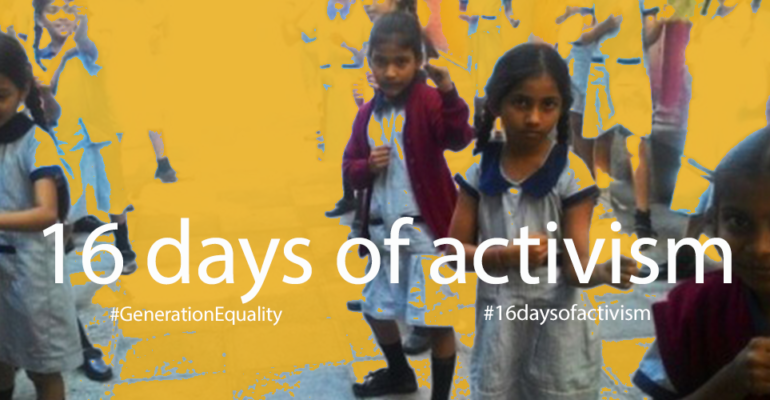Special Advisor to SI Advocacy, Linda Witong, takes a closer look at how and why climate change aggravates inequalities and increases the risks to women and girls of gender-based violence.
“The world is still ‘sleepwalking’ into the ‘catastrophe’ known as climate change – even though we have been warned that climate impacts are now hitting harder and sooner than climate assessments indicated even a decade ago. This trend is resulting in appalling impacts on our environment including our land, our freshwater systems, our oceans, the air we breathe, our ecosystems and all of earth’s inhabitants or what is left of them. For example, extreme rainfall has been involved in 8 out of the 10 natural disasters that caused the most deaths in the first half of 2017 – as eight involved floods or landslides. Storms and other weather-related hazards were also a leading cause of displacement; 76% of the 31.1 million people displaced during 2016 were forced from their homes as a result of weather-related events.

During any climate crisis, women and girls are amongst the most vulnerable to gender-based violence yet the least visible. The climate crisis continues to aggravate gender inequalities in relation to discrimination, loss of livelihood, displacement, migration, poverty, human trafficking, gender-based violence, child early and forced marriage, sexual exploitation, food insecurity, and access to infrastructure and essential services and recent research continues to link these impacts including forced marriage or trafficking of girls to climate impacts.
Women and girls are especially vulnerable to gender-based violence if they are migrating or displaced from their homes especially where they might become separated from family, friends and other potential support and protective systems. Even if they are able to remain with their families, overcrowding, lack of privacy and the collapse of regular routines and livelihood patterns may also contribute to anger, frustration, and violence, with children and women being the most vulnerable.
Child Marriage and Human Trafficking have been specifically focused on as being real and growing crises within the context of climate change within the last 6 years. As early as 2013, it was observed that 25 countries with the highest rates of child marriage were almost all affected by conflict, fragility, or natural disasters. Yet it is still reported that each year 15 million girls are still married before the age of 18 many of them in countries particularly vulnerable to climate change.

Against this backdrop of ominous warnings, a study in 2018 by Michael Gerrard of Columbia University was published. Gerrard has specifically linked the water crisis and climate change to the trafficking of women and girls who were “climate migrants” as they were more likely to fall victim to trafficking in their desperate look for security and work. Gerrard was not alone in reaching this opinion. United Nations Environment Programme has indicated that trafficking may increase by 20- 30% during disasters and INTERPOL has warned that disasters or conflict may increase the exposure of women to trafficking as families are disrupted and livelihoods are lost.
And this threat to women or girls will only get worse. According to Gerrard, while no reliable estimates existed regarding the number of people who will be displaced partly or wholly by climate change in the future, several estimates put the number of people in the hundreds of millions in the latter part of this century. Moreover, if nothing continued to be done, the world in 2100 might see an “utterly catastrophic rise” in temperatures which could result in billions of people being displaced and lead to a massive amount of conflict, smuggling, and trafficking”.
Further information
To view projects taking place on the Soroptimist International ‘Women, Water & Leadership’ Appeal 2017-2019, empowering women and building resilience to climate change – click HERE
Read recent reports on Climate Change visit the SI Recommended Reading page HERE
Find a selection of SI articles on climate change HERE
Resources:
2018 Global Risk Index: page 20 on computer, if reading the paper would be page 12
No Mother Wants Her Child to Migrate: Vulnerability of Children on the move in the Horn of Africa June 2019 UNICEF 2019
CEDAW General Recommendation No. 37: Gender-related dimensions of disaster risk reduction in the context of climate change, UN Doc. CEDAW/C/GC/37, 9 February 2018.
UNICEF Office of Research (2014). ‘The Challenges of Climate Change: Children on the front line’, Innocenti Insight, Florence: UNICEF Office of Research.
Gender Climate Change and Health WHO Migration and Displacement page 16
Why Climate Change Is Creating a New Generation of Child Brides” Gethin Chamberlain The Guardian November 26, 2018
Untying the Knot Exploring Early Marriage in Fragile States Research Report World Vision UK 2013
How Climate Change Drives Child Marriage by Lakshmi Sundarm Nov 6, 2017 Women and Girls News Deeply
Michael Gerrard, Climate Change and Human Trafficking After the Paris Climate Agreement, Sabin Center for Climate Change Law, Columbia Law School (2016)

